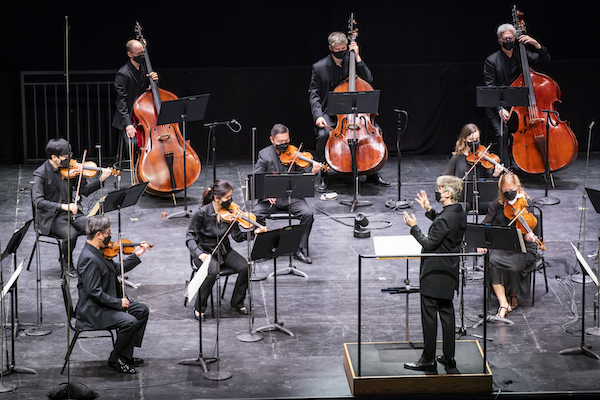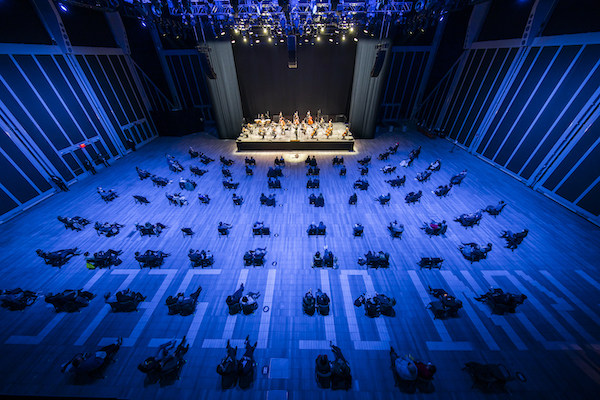One year later, the Philharmonic looks forward with a reflective program for strings

The New York Philharmonic last played live and in front of an audience on March 10, 2020. That long, dreary hiatus was broken Wednesday night at The Shed when a reduced Philharmonic ensemble, led by guest conductor Esa-Pekka Salonen, played string orchestra works by Caroline Shaw, Sibelius, and Richard Strauss.
It was far from a normal experience—as defined by the usual evening subscription concert with full orchestra at Lincoln Center—with features that were of a kind one would prefer not to get used to. Still, it was a concert and a notable one.
As Salonen said in his brief opening remarks, “Nothing, absolutely nothing, can replace the act and ritual of live concerts.” This is close to being an objective truth in the performing arts, as a year of remote streaming has demonstrated. Being together for live music increases social bonds among all at hand, musicians and audiences, and that both enhances the vitality of the music making in a positive feedback loop and creates the deep and unpredictable alchemy of a live performance. The point of being present, live, is to not just hear something but feel something. Salonen also spoke of the common thread in the program, a shared quality of “longing, nostalgia, and loss,” and Shaw’s Entr’acte, Sibelius’s Rastavara and Strauss’s Metamorphosen opened up a lot of feelings in this one-hour concert.
The venue alone was a concession. The Shed at the Hudson Yards arts center is the kind of convertible, flexible venue that can build a stage for an ensemble of a couple dozen musicians while also managing the floor space for a reduced, socially distanced audience—which Wednesday meant 150 people, 12% of the capacity of the cavernous space.
Pairs and single seats were positioned in definite rows but with more than six feet between each. Everyone—audience, staff, and musicians—was masked, and ticket-holders had to show either a negative Covid test taken within the last 72 hours or proof of full vaccination; proof of identification; and pass a temperature screening. Both entrance and post-concert exit were timed so as to eliminate crowding, nothing at all like David Geffen Hall. There were no programs–one scanned a QR code to pull up a digital program on a smartphone. Watching over the top of one’s mask, seeing a stage full of masked performers, their expressions hidden, was a clear separation from the long-standing concert experience. But the performance fit right into years of experience going to see the Philharmonic.
The cube-like McCourt space with its soaring roof did not bode well for the acoustic, but the strings sounded rich and had a real presence even as the distances seemed dramatically deep. The only real sonic drawback was that the noisy HVAC system drowned out the quiet parts of Shaw’s Entr’acte, including much of the concluding cello solo.
But the Philharmonic gave what seemed an effortless heft to the music, the players projected clear focus under Salonen, and just listening to great music and playing of such considerable quality provided its own significant rewards.
Shaw’s piece was a smart way to begin. Entr’acte was initially an afterthought, as the Philharmonic first announced the opener would be Arvo Pärt’s Cantus in Memoriam Benjamin Britten. Only after a social media outcry over the lack of anything contemporary on the program was that replaced with Shaw’s work.
Pärt’s piece looks backward and mourns, Entr’acte touches on unsettled feelings but looks forward. The music is always leaning slightly into the future, poised, like a dancer en pointe, to move on to the next thing. It’s about transitions from one thing to another, being between things but not in stasis. Philosophically, there’s little that could better express what one could be feeling in general right now, and the orchestra fully captured that sense of poise.
The consonance of her piece was one of the musical features of everything on the program, as well as her purpose to catch the ear with something that was sonically appealing and touch the heart with genuine expression. Rakastava (The Lover), Op. 14, is so rare on concert programs that it felt new. It’s a small piece, sweet-sounding, with Sibelius’ virtues of a glowing resonance and the sense of gliding across time. This was a graceful, shining performance from the Philharmonic, the muted strings burnished and touching on the inner stillness and peace that is an important part of Sibelius’ art.
Shaw’s music connected to reality, Sibelius was something of a dream, and Strauss, unexpectedly, returned one to the present. Metamorphosen is often heard via performances that push the music to a romantic extreme, but this one was sober and directed away from dwelling on inner turmoil and toward the outside world. This seemed to get at the essence of the evening, which was less about loss and nostalgia, and looking backward than setting the evening’s concert as the point where the past ended and the future might begin to take shape again.
From the throaty, wood timbres of the cellos and violas at the start of the piece, the orchestra played Metamorphosen with a sensation of clear-eyed finality. Salonen kept everything flowing, letting the music unroll with no undue lingering or interpretive over-emphasis. Everything, even the quote from the funeral march of Beethoven’s “Eroica”, had the feeling of a long overdue discarding of the weight of frustration, waiting, anxiety. This was Strauss as, amazingly, a long, refreshing and timely exhalation.
This program will be repeated at The Shed, 8 p.m. Thursday. nyphil.org
